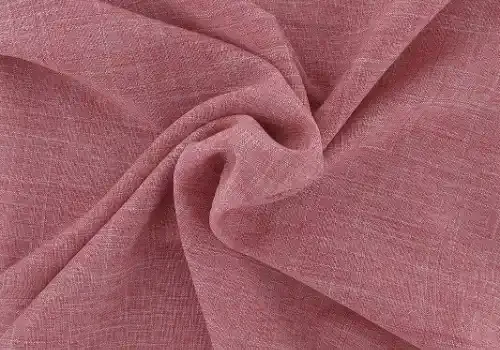Introduction
Linen cotton blend fabric is a textile material that blends linen and cotton fibers. This combination of natural fibers produces a versatile fabric with unique properties and characteristics.
Linen cotton blend fabric
Linen, derived from the flax plant, has been used for centuries due to its exceptional breathability, durability, and moisture-wicking capabilities. On the other hand, cotton is one of the most widely used fabrics worldwide because of its softness, comfort, and ease of care. Combining these two fibers into a blend forms a new fabric that inherits desirable qualities from both materials.
One key advantage of linen cotton blend fabric is its enhanced breathability. Linen itself is known for its ability to allow air to circulate freely through it. The addition of cotton further improves the airflow within the fabric structure. As a result, garments made from linen-cotton blends feel lightweight and relaxed on the body, even in hot weather conditions or during physical activities.
Another notable characteristic of linen-cotton blends is their strength and durability. While 100% linen can sometimes be prone to wrinkling or becoming stiff over time due to its lack of elasticity, adding cotton fibers helps alleviate these concerns. Cotton provides additional flexibility and resilience to the fabric while maintaining some wrinkle resistance. Consequently, garments made from linen-cotton blends tend to retain their shape better than pure linens.
The combination also brings about improved moisture management properties to the blended fabric. Linen and cotton have excellent absorbency capabilities; they can absorb sweat or moisture efficiently without feeling damp against the skin. This feature makes garments crafted from linen-cotton blends highly suitable for warm climates or intense physical activities where perspiration may occur.
Additionally, thanks to its natural composition derived from renewable sources (flax plants for linen and cotton plants), linen-cotton blend fabrics possess eco-friendly attributes compared to synthetic textiles like polyester or nylon, which require extensive chemical processes during manufacturing.
Furthermore, another advantage of linen-cotton blend fabric lies in its versatility. This type of textile can be used to create a wide range of clothing items, such as dresses, shirts, pants, and skirts. Combining the crispness and structure of linen with the softness and drape of cotton allows for diverse design possibilities.
Regarding care instructions, linen-cotton blends generally require relatively simple maintenance compared to pure linen fabrics. They can often be machine-washed or dry-cleaned without excessive shrinkage or distortion.
Overall, linen-cotton blend fabric offers a balanced fusion of qualities from both natural fibers. Its breathability, durability, moisture management properties, eco-friendliness, and versatility in garment production make it a popular choice among designers and consumers. Whether for casual wear on hot summer days or elegant evening attire with added texture and character, garments made from linen-cotton blends provide comfort and style while being mindful of sustainability considerations.
Best linen cotton blend fabric dressmaking
Dressmaking is a craft cherished by individuals worldwide, as it allows for the creation of unique and personalized garments. One fabric option gaining popularity among dressmakers is the linen cotton blend. Combining the best characteristics of linen and cotton, a linen cotton blend fabric offers numerous advantages in comfort, durability, versatility, and aesthetics. Dressmaking with a focus on why a linen cotton blend fabric is considered one of the best choices for creating exquisite garments is discussed below-
i. Comfort
Linen cotton blended fabrics offer exceptional comfort to those who wear them. Linen fibers possess notable moisture-wicking properties, allowing them to swiftly absorb sweat from the body. Additionally, they promote airflow due to their breathable nature, ensuring proper ventilation even in warm climates or during vigorous activities. When combined with soft and smooth cotton fibers, these qualities create garments with superior breathability and overall comfort.
ii. Durability
Durability is pivotal in selecting suitable fabrics for dressmaking projects since well-crafted garments should stand the test of time. The combination of linen and cotton enhances strength while maintaining flexibility. Linen's robustness adds resilience to clothing items made from such blends while retaining its shape after multiple uses and washes. Simultaneously, cotton's natural elasticity prevents excessive stretching or deformation over time – leading to longer-lasting apparel.
iii. Versatility
Versatility is another crucial factor when considering fabric options for dressmaking endeavors – having materials adaptable to various styles is crucial for designers seeking flexibility in their creations. A linen-cotton blend encompasses excellent versatility due to its ability to amalgamate different textures successfully. Whether designing flowing dresses or tailored suits, linens' crisp texture can lend structure when required; blending it with softer elements like combed cotton allows for draping effects desired in more flowy designs.
iv. Aesthetics
The aesthetic appeal offered by linen cotton blend fabrics is undeniable. These blends bestow garments with a subtle and sophisticated charm, creating a visually pleasing effect. Linen fibers possess natural irregularities, resulting in unique textures and patterns when woven with the smoothness of cotton fibers. This combination offers depth to the fabric, elevating its visual allure and making it particularly suitable for elegant dressmaking projects.
Choosing the suitable fabric is paramount to achieving remarkable results when embarking on a dressmaking journey. The linen cotton blend is among the finest options available due to its exceptional comfort, durability, versatility, and aesthetic appeal. By blending these two distinct materials, dressmakers can fashion garments that meet various requirements – from breathability in warm weather to longevity over time. Whether designing casual attire or formal wear, considering a linen-cotton blend fabric for your next dressmaking project will undoubtedly contribute to crafting exquisite pieces bound to impress both wearers and admirers alike.










0 Comments